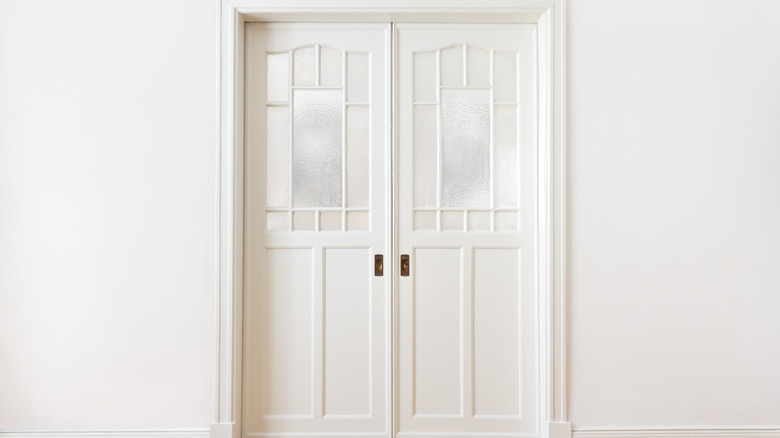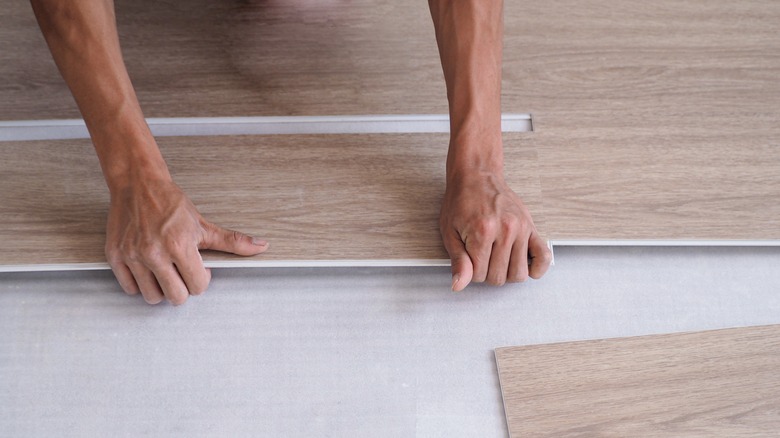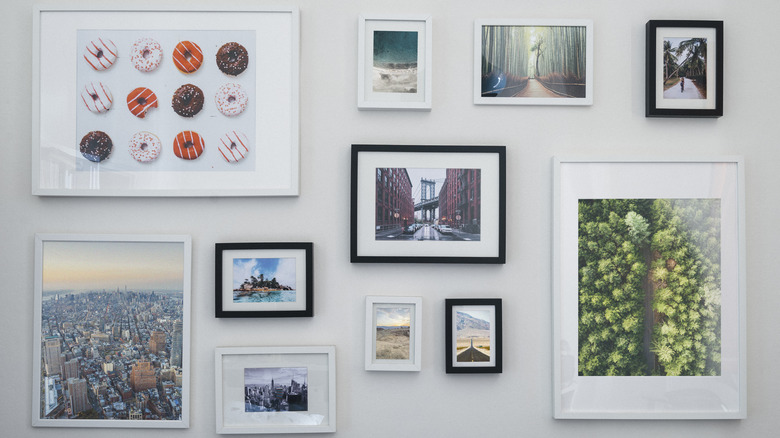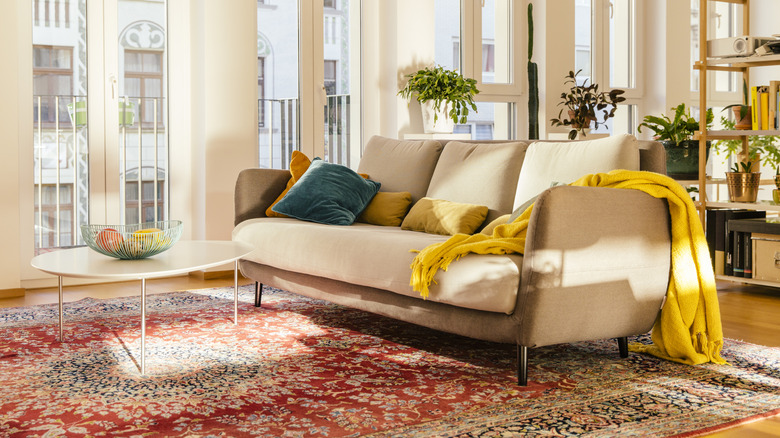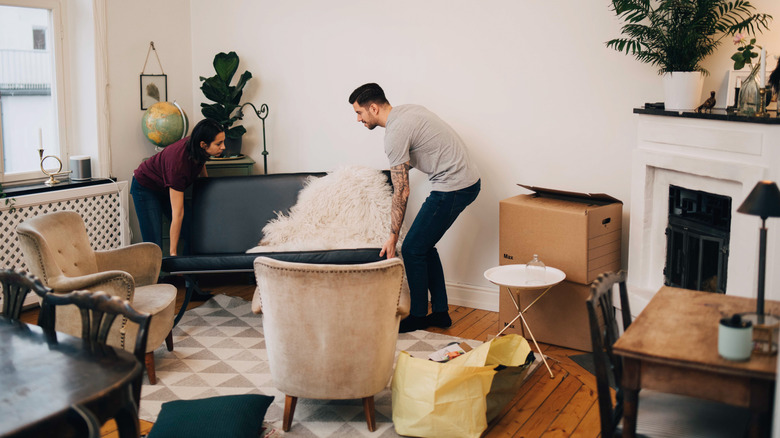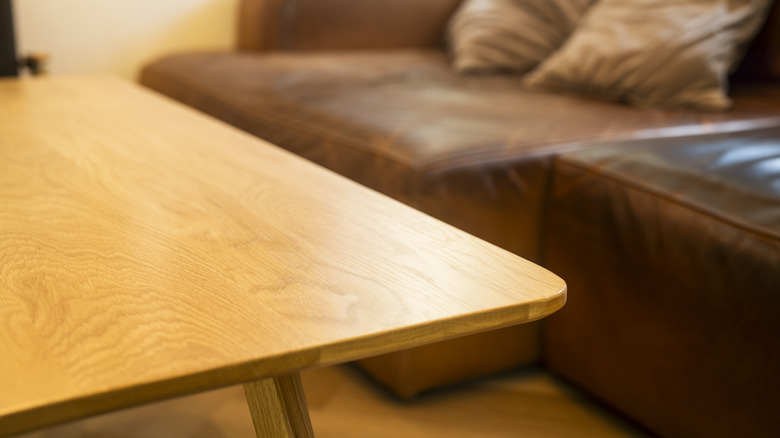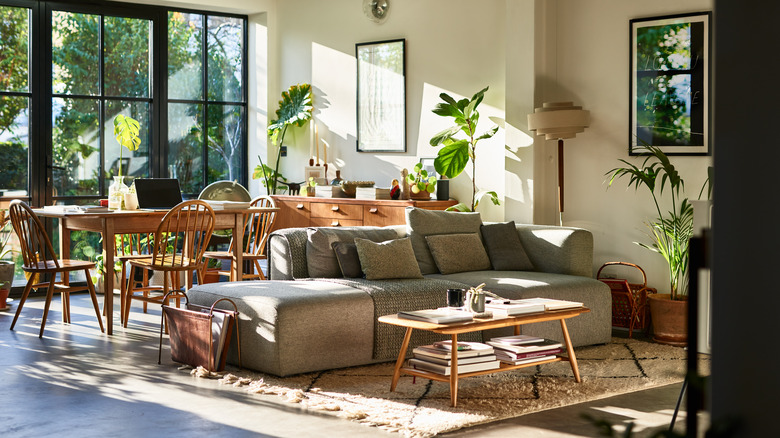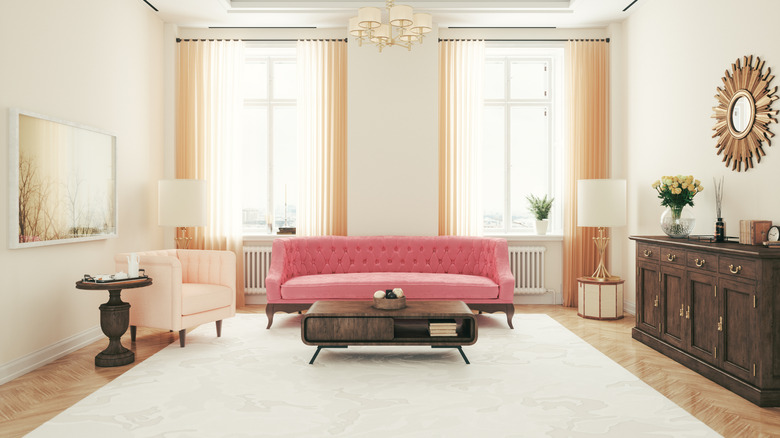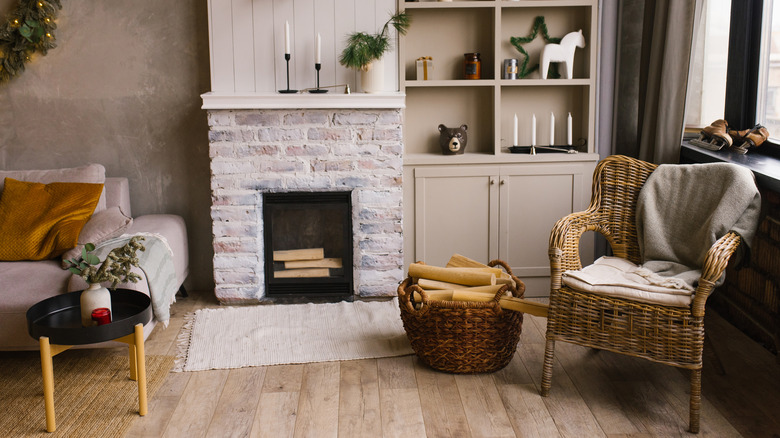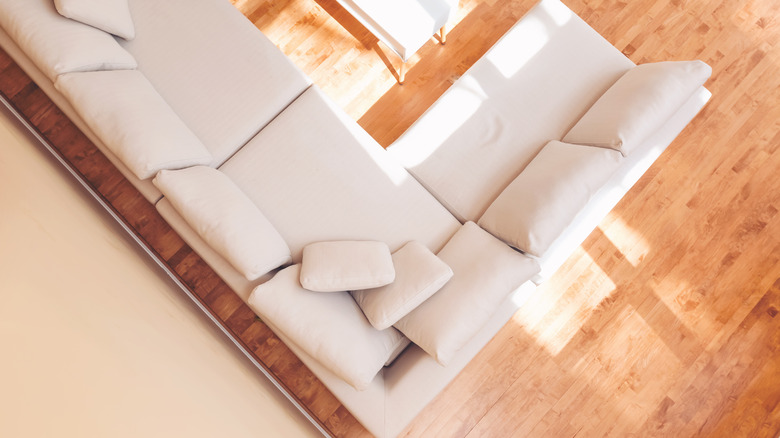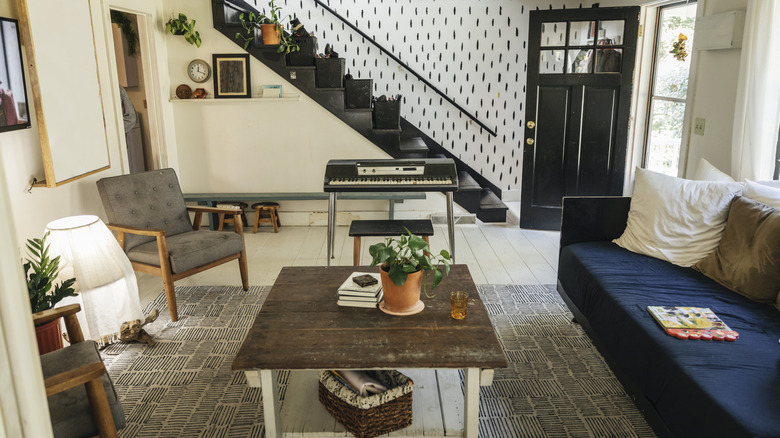The Property Brothers' Best Living Room Design Ideas And Advice
We may receive a commission on purchases made from links.
From the biggest to the smallest design ideas for the living room — the Property Brothers love them all. Drew and Jonathan Scott are known for their keen eye for real estate, remodeling, and decorating, and for keeping clients happy across their many HGTV shows. Most of all, they know how to transform spaces like the living room with clever design tricks in practical, budget-friendly ways that still turn out to be incredibly stylish. "You don't need to rip open walls to transform a space. One of the big things that count is furniture design and painting — things you can do yourself — that alone can transform the space," Drew told NBC News.
And if you're not sure where to begin with the decorating process, no problem. We've rounded up the brothers' best living room design ideas and advice. From how to hang art so your gallery wall looks chic and not crowded to the best colors to paint the space so it feels bigger than it actually is — the Scott brothers know exactly how to transform your living room from drab and unusable to fabulous and functional.
Stick to classic door types, instead of just following trends
If you don't have an open floor plan, knowing what type of door to use for your living room can be tricky. Yet the boys think that keeping things classic is best from an aesthetic standpoint. "Barn doors have been overdone. They're perfect for certain solutions, but not for every solution," Jonathan told Good Housekeeping. Instead of following trends like barn doors, go for a typical swinging door, a simple pocket door, or just no door at all.
In fact, when designing a space, Jonathan prefers making a living room as open as possible, when you can. "I don't think you're going to have fully compartmentalized houses like they did in the past," he said in a "Block Talk" Q&A session when asked for his opinion on whether open-concept floor plans are ever going out of style. Instead, maintaining a connection between the living room, dining room, and kitchen fosters community and keeps the conversation flowing while you are entertaining. If you can't afford to take down a wall, consider simply removing the door as a happy medium to accomplish this feeling.
You don't need hardwood floors in the living room to be luxurious
When it comes to the best flooring choices to consider for living rooms, hardwood and look-alike alternatives are top picks. While the brothers are no strangers to using hardwood, "there are much better products that are far more durable," Drew told Good Housekeeping. "Luxury vinyl is an example [of a material] that can look like hardwood, but it's way more durable." LVP is scratch-resistant and won't warp in changing weather like hardwood might. It also tends to be less expensive overall.
Here's a Property Brothers tip for making new flooring look good: If you use LVP (luxury vinyl plank) in your living room and you do have an open concept home, you'll need to stick with it in other areas of the house too — like the entryway, kitchen, etc. — if they can be seen from the space. "I have a rule: You should never see more than two types of flooring from any one place in your home," Jonathan told viewers in the "Finding a Positive Balance" episode of "Property Brothers: Forever Home," per Realtor.com. "So we're laying the luxury vinyl flooring throughout the entire main living areas." This way, there is a bit of visual cohesion throughout the space and your home's flooring doesn't look too much like a patchwork quilt.
Add art to your living room walls for a touch of personality
Art is one of the best design pieces you can add to your living room, because it allows you to express yourself. No matter if you are going for a modern look, a mid-century time capsule, or even farmhouse chic, you'll be able to hang a painting or photo that fits both the style and your taste. "Whenever anyone puts decor or artwork on the walls, it's always personal," Drew told NBC News. "You want people to come into your home and see something that reflects your personality."
The type of art isn't important, as you should choose what speaks to you. What is important, however, is how you display it. "When hanging wall art, the layout and spacing is art in itself," Jonathan told Bustle. He has two rules for arranging pieces so that they always look their best. The first is to "Leave two inches between frames no matter what your formation." This way, even a gallery wall that is filled to the brim with frames won't look messy or overcrowded. Next, he says to "make sure the proportion of artwork to the wall is balanced. Artwork that is too small makes your wall look sad!" This means that the larger the frame, the less art you might need. Yet, if you only have a few small photographs, you'll need more of them arranged in a pattern to fill out the space.
There are definite rules for styling area rugs
If you have tile, LVP, or hardwood as flooring in your living room, you'll likely want to have an area rug in the space, too. The fabric of these rugs can help with noise control, provide something softer underfoot (which is great in the winter months), and add another touch of style. Nailing the size of the rug so it fits well in the space is ultra-important. "The distance between an area rug and at least one wall should be between 12 and 18 inches so that flooring is visible," the brothers wrote in their book "Dream Home," per Oprah.com. "In oversized great rooms you can increase that distance between wall and rug or have it completely free floating in the center of the room if the space is big enough."
Once you have measured where the rug falls in relation to the wall, it's time to consider how it interacts with the furniture in the living room. "The front legs of your sofa and chairs should sit on an area rug — ideally the entire furniture grouping should be within the perimeter of an area rug," they said. By following these rug rules, your living room will seem to-scale.
Think about the bigger picture when picking items out for the room
When designing your living room, some of the brothers' best advice is to simply plan ahead. "Another thing is that a lot of people will say, 'I love this.' They'll buy it. Then another thing, 'I love that!' Then they'll buy that," Drew told Realtor.com. "And they're jumping around buying all these different elements." The problem with this, though, is that the style in your space isn't going to have any cohesion. In some cases, like in maximalist design, having a crowded space that's loud and bold will work perfectly. Yet, if that's not what you are going for, it's easy to overwhelm yourself if you aren't shopping with some sort of plan in mind.
Drew warned that this could quickly become a problem. "And I'm all for an eclectic design — you don't want everything to be all matchy-matchy-matchy," he said. "However, sometimes people get all these different items, and then they realize it all just doesn't work together." Instead, before you hit the garage sale or home decor store, take a moment to piece together what you are looking for. It's one thing to impulsively pin a hodgepodge of things to your inspiration board. It's something else entirely to actually buy all of those things and try to figure out how they fit together once you've already spent the money.
Keep corners rounded when designing family spaces
The living room is often a space where the entire family gathers, so the brothers think it's important to consider all members of the household when setting it up. "One of the big struggles that people have is to figure out what comes first, style or safety. That's why a lot of our pieces have rounded corners, where you have that safety for children," Drew told Realtor.com when discussing how he and his wife are styling their home with their growing family in mind.
As your family changes, you might have to get rid of some of your favorite pieces, at least for a season, so the room is safe for everyone. "In my living room, I actually have some chairs I love. They're a beautiful mid-century modern look," Drew continued. "But they have super sharp corners. I actually broke a toe on one of those chairs. And so we have those and our coffee table that we're swapping out for some of our pieces that have rounded corners." Of course, as your children grow, you can gradually introduce more adult-friendly pieces back into the space. So if you are really attached to your mid-century chairs, for example, just pop them in the attic instead of selling them on Facebook Marketplace. This way, you'll get to enjoy them again one day.
There actually is a perfect coffee table size
When furnishing your dining room, you might think that the perfect coffee table is the best-looking one. But there is another consideration: Its size. The Property Brothers have a very particular formula they think you should follow to get the best results. "Most sofa seats are 17 to 20 inches high, so an adjacent coffee table should be 15 to 18 inches high," they wrote in their book "Dream Home," per Oprah.com. "Perfect height for putting your feet up ... not that our mom encourages that."
Once you've nailed the table's height, you also need to consider its staging in relation to the sofa and other pieces of furniture. Luckily, the brothers cover that in their book, too. "Allow around 18 inches between the coffee table and sofa edge to provide comfortable leg room — that's close enough to set down drinks or reach snacks without straining or getting up." It also leaves enough room to sit down comfortably without your knees banging into the table should you choose not to use it and just enjoy the couch instead.
Consider scale when picking furniture for your living room
"Size is so important. You will get someone who sees something beautiful and says, 'Oh my gosh, I want it,' and they get it home and they realize, 'Well, now you have to turn sideways to shimmy past it to get into the next room,'" Jonathan told Realtor.com. This is why if you are purchasing living room furniture for the first time, consider taping out the dimensions in your living room before buying anything. You can do this with painter's tape so it doesn't damage the floor when you pull it up. This way, you know the exact shape and size of the furniture you can fit in your space ahead of time and aren't left scratching your head at the store.
Jonathan agreed, telling the outlet, "Make sure you measure everything out. Every iPhone has a measuring app built into it. Make sure size is being thoughtfully considered." If you aren't as tech-savvy, or prefer the old-fashioned way, you can use a ruler, measuring tape, or even a yardstick to record distances. Be sure you know the total square feet of the room, its width, length, and depth, as well as how wide the doorway is — to load and unload larger furniture pieces.
Choosing different finishes for bigger items can add visual interest
Instead of lots of colors within the living room, the brothers sometimes suggest using contrasting textures or finishes to add personality. "I chose a lot of high-contrast finishes in neutrals, so there's plenty of visual interest without going over the top," Drew said in an interview with Drew + Jonathan Reveal magazine about a living room he designed. "The Scott Living dark display cabinets help draw your eye toward the fireplace as a focal point in the room."
His brother agrees with styling living rooms by building out from a neutral palette in this way. "It's important to realize that with design, neutral can be a great thing," Jonathan told Realtor.com. "So when you look at a lot of these tones, they're neutral but they're not in any way boring. They're beautiful, and there's another story to be told from the textures of the fabrics." You can incorporate this into your own living room by considering a light couch, or dark wooden accent furniture like a bar cart or coffee table, then add more texture with glass shelving or metal storage units. As long as the textures and finishes of each item contrast, you'll achieve the look the brothers are going for.
Sofas should be both comfortable and chic
Picking the right sofa is essential for a functional and stylish living room. It's the main attraction in the space, so you do have to nail it. Given the above tip, the best couch colors to choose fall in the neutral range (unless you're a committed maximalist). But don't let color and shape be all you think about. If you put too much emphasis on style and not enough on comfort, you might end up with something that looks great when passing by, but you can't stand to sit on for more than 30 minutes. Remember, you aren't creating a magazine cover, but rather a space you can actually live in. To solve this, the Scotts suggest going big or going home. "No home is complete without a really great sectional that you can adapt to your space to make it perfect," Drew told Realtor.com. "Picture get-togethers with family and friends, movie nights with the family, whatever you're doing, it makes it feel like home."
While sectionals are larger, everyone can fit on them. You don't need to worry about whether or not your accent chair fits into the space or matches the couch because you won't need one. However, double and triple checking the measurements of the space is extra important when buying a sectional as they tend to come in either U or L shapes. You want to be sure that even with the bends, they still fit.
Textured wallpaper can make the space feel cozier
If you don't want plain painted walls, consider adding a pop of personality with wallpaper. The Scott brothers have their own line of options, but know that any brand will add depth and visual interest to your living room. "Since the room is quite large, I wanted to add the grasscloth, which helps make it feel like a more intimate setting," Jonathan told Drew + Jonathan Reveal when describing the steps he took to make a large living room feel cozier for a family in Pittsburgh.
You can use permanent wallpaper if you own your home and peel-and-stick options if you are in a rental. In either case, you might need to touch up the walls before applying the paper, so that it lays as it's supposed to. "Now it helps if you have a smooth dry clean wall so you might want to have some painting done before installing the wallpaper," Drew told WallPops. "In that case, you should also allow a month between painting and hanging wallpapers so the paint can fully dry and cure."
Choose light, bright paint for the walls
The color on the walls in your living room is foundational to its design. If you pick something too dark and overbearing, the space can feel cramped. Even neutrals, when not styled correctly, can feel sterile instead of cozy. Luckily, swapping out the paint is an easy, low-cost DIY that most people can handle in a day or two. "Give a room a breath of fresh air by repainting with a brighter color," Drew advised during an interview with Bustle.
When selecting lighter colors, the brothers' favorite options are white, gray, and blue-green. They insist that these hues will never go out of style — so if you use them in your living room, you won't need to swap out the paint again in the near future. These shades also go with most other colors, so you can still keep your furniture and other decor pieces in place, since they won't clash. Before committing to a hue, however, be sure to paint a few test strips on the wall. Have a look at them at different times of day, in different types of light, just to make sure you choose one you are really happy with.

